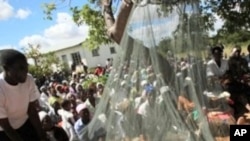The U.N.Children's Fund and the government of the Central African Republic are distributing more than one-million insecticide treated mosquito nets in the African nation to protect children and pregnant women from malaria.
The Central African Republic has one of the highest child mortality rates in the world. More than 170 out of 1,000 children die before reaching their fifth birthday.
UNICEF spokeswoman Christiane Berthiaume tells VOA malaria accounts for 19 percent of these deaths.
"It is easy to fight malaria. You can do that with a simple mosquito net, which is treated with a kind of insecticide," said Berthiaume. "And, so the aim of UNICEF is to put at least one mosquito net into each of the country's nearly 900,000 households in the coming months."
But Berthiaume says more must be done. She says UNICEF needs an additional 1.5 million long-lasting insecticide-treated mosquito nets and $1 million to be able to achieve universal coverage for all people at risk of malaria.
She says this investment is cheap considering the benefits.
"Regular use of a mosquito net can decrease malaria mortality by about 20 percent and malaria incidence by 50 percent in children age under five," she added. "This is very important. The children and the pregnant women are the most at risk in this country."
UNICEF hopes to distribute all the nets before the rainy season begins and malaria becomes a huge problem.
As part of the distribution campaign, Berthiaume says aid workers will go door-to-door to demonstrate how to hang up a net and to persuade every family that sleeping under it could save their children's lives.
UNICEF says it will be able to reach most people in the Central African Republic. But, it says continuous instability in the north is making it difficult to reach large parts of the population.
This includes more than 300,000 internally displaced, returnees and refugees from neighboring countries.













